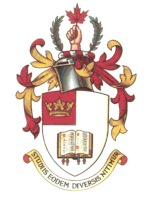|
Royal Society of Canada
The Royal Society of Canada (RSC; French: Société royale du Canada, SRC), also known as the Academies of Arts, Humanities, and Sciences of Canada (French: Académies des arts, des lettres et des sciences du Canada), is the senior national, bilingual council of distinguished Canadian scholars, humanists, scientists, and artists. The primary objective of the RSC is to promote learning and research in the arts, the humanities, and the sciences. The RSC is Canada's national academy. It promotes Canadian research and scholarly accomplishment in both official languages, recognizes academic and artistic excellence, and advises governments, non-governmental organizations, and Canadians on matters of public interest.[1] HistoryIn the late 1870s, the Governor General of Canada, John Campbell, Marquis of Lorne, determined that Canada required a cultural institution to promote national scientific research and development. Since that time, succeeding governors general have remained involved with the affairs of the Society. In 1882, the Royal Society of Canada was founded with the personal patronage of Lord Lorne. A year later, in 1883, the Society was incorporated by an act of the Parliament of Canada. From its founding until the early 1900s, the structure of the RSC imitated the model of the Royal Society of London, but with the important addition of literature and other elements found in the Institut de France. Like their counterparts, membership to the RSC was limited and by election. Initially, the RSC was divided into four sections, each of 20 Fellows. These sections were: French literature, history, and archaeology; English literature, history, and archaeology; mathematical, physical and chemical sciences; and geological and biological sciences. The founding fellows of the RSC included Sandford Fleming, the originator of the world system of Standard Time, and William Osler, one of the greatest physicians of his time. The fellows of the RSC were nominated by a committee directed by the Principal of McGill University, John William Dawson, and by the former Premier of Quebec, Pierre Chauveau. These two men served as the first and second presidents of the Society.  As Canadian scholarship and research increased, the RSC also grew. Within three decades, the fellowship of the RSC doubled in number. After several phases of restructuring, the RSC evolved its contemporary organization. In 2010, Governor General David Johnston was elected as an honorary fellow of the Society. Organization and purposeThe Royal Society of Canada currently consists of more than 2,000 fellows: men and women from all branches of learning who have made contributions in the arts, the humanities, and the sciences, as well as in Canadian public life.[2] Presently, the fellowship comprises four categories: regularly elected fellows, specially elected fellows, foreign fellows, and honorary fellows. Each year, approximately 80 people are elected to the fellowship. This cohort includes approximately 75 regularly elected fellows recommended by the divisions, as many as six specially elected fellows, as many as four foreign fellows, and a maximum of one honorary fellow. Once inducted into the Society, anglophone fellows may use the post-nominal letters FRSC (fellow of the Royal Society of Canada) and francophone fellows may use MSRC (membre de la Société royale du Canada). The RSC is composed of three bilingual academies, including a broad range of scholarly disciplines and artistic fields. Academy I is the Academy of Arts and Humanities. There are three divisions of Academy I: an anglophone division, humanities; a francophone division, letters and humanities; and a bilingual division for the arts, embracing architecture, creative writing, and other arts. Academy II is the Academy of Social Sciences. There are two divisions of Academy II: an anglophone division, social sciences; and a francophone division, social sciences. Academy III is the Academy of Science. There are four bilingual divisions of Academy III: Applied sciences and engineering; Earth, ocean, and atmospheric sciences; life sciences; and mathematical and physical sciences. The Society is dedicated to making its members’ varied knowledge available to the public. Members are available to assess issues of presumed value to Canadians and provide independent expert advice, notably to government on matters of public policy through its program of expert panel reports. The College of New Scholars, Artists, and ScientistsThe College of New Scholars, Artists, and Scientists of the RSC was established in 2014 to represent emerging generation of intellectual leaders in Canada. It elects 80–100 members each year, who showed high level of accomplishments at the early stage of their careers. At the time of election, members of the College must have received a PhD or equivalent degree within the past 15 years. Nomination of candidates for the College follows a similar procedures as nomination for the fellows of RSC.[3] Institutional membersThe RSC officially began the Institutional Member (IM) Program in 2004. The goal was to provide a mechanism by which the Society could develop its programs in conjunction with Canadian universities and by which universities could have formal and direct input into the strategic organization and governance of the Society. This closer relationship facilitates the nomination of new fellows from all Canadian universities and provides a means for the Society to sponsor scholarly activities at institutions of all sizes across Canada. Presently, 46 universities and the National Research Council of Canada are institutional members of the Society. Medals and awards The RSC recognizes notable achievements in research and innovation by awarding medals and prizes. Twenty Society awards are offered on an annual or biennial basis and consist of either medals or certificates, some of them with cash prizes. These awards are as follows:
Arms
See also
ReferencesCitations
Sources
External linksWikimedia Commons has media related to Royal Society of Canada. |
||||||||||||||||||||||||||


